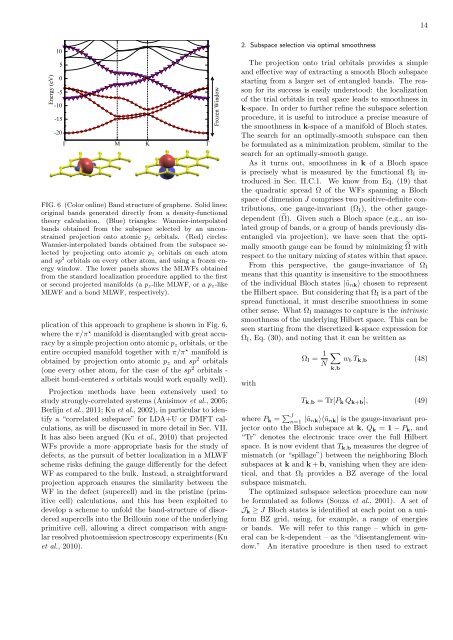Maximally localized Wannier functions: Theory and applications
Maximally localized Wannier functions: Theory and applications
Maximally localized Wannier functions: Theory and applications
Create successful ePaper yourself
Turn your PDF publications into a flip-book with our unique Google optimized e-Paper software.
14<br />
Energy (eV)<br />
10<br />
5<br />
0<br />
-5<br />
-10<br />
-15<br />
-20<br />
Γ M K Γ<br />
FIG. 6 (Color online) B<strong>and</strong> structure of graphene. Solid lines:<br />
original b<strong>and</strong>s generated directly from a density-functional<br />
theory calculation. (Blue) triangles: <strong>Wannier</strong>-interpolated<br />
b<strong>and</strong>s obtained from the subspace selected by an unconstrained<br />
projection onto atomic p z orbitals. (Red) circles:<br />
<strong>Wannier</strong>-interpolated b<strong>and</strong>s obtained from the subspace selected<br />
by projecting onto atomic p z orbitals on each atom<br />
<strong>and</strong> sp 2 orbitals on every other atom, <strong>and</strong> using a frozen energy<br />
window. The lower panels shows the MLWFs obtained<br />
from the st<strong>and</strong>ard localization procedure applied to the first<br />
or second projected manifolds (a p z -like MLWF, or a p z -like<br />
MLWF <strong>and</strong> a bond MLWF, respectively).<br />
plication of this approach to graphene is shown in Fig. 6,<br />
where the π/π ⋆ manifold is disentangled with great accuracy<br />
by a simple projection onto atomic p z orbitals, or the<br />
entire occupied manifold together with π/π ⋆ manifold is<br />
obtained by projection onto atomic p z <strong>and</strong> sp 2 orbitals<br />
(one every other atom, for the case of the sp 2 orbitals -<br />
albeit bond-centered s orbitals would work equally well).<br />
Projection methods have been extensively used to<br />
study strongly-correlated systems (Anisimov et al., 2005;<br />
Berlijn et al., 2011; Ku et al., 2002), in particular to identify<br />
a “correlated subspace” for LDA+U or DMFT calculations,<br />
as will be discussed in more detail in Sec. VII.<br />
It has also been argued (Ku et al., 2010) that projected<br />
WFs provide a more appropriate basis for the study of<br />
defects, as the pursuit of better localization in a MLWF<br />
scheme risks defining the gauge differently for the defect<br />
WF as compared to the bulk. Instead, a straightforward<br />
projection approach ensures the similarity between the<br />
WF in the defect (supercell) <strong>and</strong> in the pristine (primitive<br />
cell) calculations, <strong>and</strong> this has been exploited to<br />
develop a scheme to unfold the b<strong>and</strong>-structure of disordered<br />
supercells into the Brillouin zone of the underlying<br />
primitive cell, allowing a direct comparison with angular<br />
resolved photoemission spectroscopy experiments (Ku<br />
et al., 2010).<br />
Frozen Window<br />
2. Subspace selection via optimal smoothness<br />
The projection onto trial orbitals provides a simple<br />
<strong>and</strong> effective way of extracting a smooth Bloch subspace<br />
starting from a larger set of entangled b<strong>and</strong>s. The reason<br />
for its success is easily understood: the localization<br />
of the trial orbitals in real space leads to smoothness in<br />
k-space. In order to further refine the subspace selection<br />
procedure, it is useful to introduce a precise measure of<br />
the smoothness in k-space of a manifold of Bloch states.<br />
The search for an optimally-smooth subspace can then<br />
be formulated as a minimization problem, similar to the<br />
search for an optimally-smooth gauge.<br />
As it turns out, smoothness in k of a Bloch space<br />
is precisely what is measured by the functional Ω I introduced<br />
in Sec. II.C.1. We know from Eq. (19) that<br />
the quadratic spread Ω of the WFs spanning a Bloch<br />
space of dimension J comprises two positive-definite contributions,<br />
one gauge-invariant (Ω I ), the other gaugedependent<br />
(˜Ω). Given such a Bloch space (e.g., an isolated<br />
group of b<strong>and</strong>s, or a group of b<strong>and</strong>s previously disentangled<br />
via projection), we have seen that the optimally<br />
smooth gauge can be found by minimizing ˜Ω with<br />
respect to the unitary mixing of states within that space.<br />
From this perspective, the gauge-invariance of Ω I<br />
means that this quantity is insensitive to the smoothness<br />
of the individual Bloch states |ũ nk ⟩ chosen to represent<br />
the Hilbert space. But considering that Ω I is a part of the<br />
spread functional, it must describe smoothness in some<br />
other sense. What Ω I manages to capture is the intrinsic<br />
smoothness of the underlying Hilbert space. This can be<br />
seen starting from the discretized k-space expression for<br />
Ω I , Eq. (30), <strong>and</strong> noting that it can be written as<br />
with<br />
Ω I = 1 ∑<br />
w b T k,b (48)<br />
N<br />
k,b<br />
T k,b = Tr[P k Q k+b ], (49)<br />
where P k = ∑ J<br />
n=1 |ũ nk⟩⟨ũ nk | is the gauge-invariant projector<br />
onto the Bloch subspace at k, Q k = 1 − P k , <strong>and</strong><br />
“Tr” denotes the electronic trace over the full Hilbert<br />
space. It is now evident that T k,b measures the degree of<br />
mismatch (or “spillage”) between the neighboring Bloch<br />
subspaces at k <strong>and</strong> k + b, vanishing when they are identical,<br />
<strong>and</strong> that Ω I provides a BZ average of the local<br />
subspace mismatch.<br />
The optimized subspace selection procedure can now<br />
be formulated as follows (Souza et al., 2001). A set of<br />
J k ≥ J Bloch states is identified at each point on a uniform<br />
BZ grid, using, for example, a range of energies<br />
or b<strong>and</strong>s. We will refer to this range – which in general<br />
can be k-dependent – as the “disentanglement window.”<br />
An iterative procedure is then used to extract













